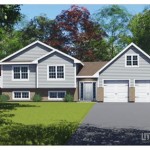Essential Aspects of House Plans for Sloping Lots
Designing a house plan for a sloping lot presents unique challenges and opportunities. Understanding the essential aspects of house plans for sloping lots can help you create a beautiful, functional, and safe home.
1. Site Evaluation
Thoroughly evaluate the slope, soil conditions, drainage patterns, and access to the site. These factors will influence the design of the house and the foundation system required.
2. Foundation Design
Sloping lots often require specialized foundation systems, such as stepped or terraced foundations. These foundations provide adequate support and stability on uneven ground.
3. House Placement
Position the house on the slope to minimize grading and maximize views. Consider the orientation of the house to take advantage of natural light and minimize wind exposure.
4. Floor Plan Layout
Design the floor plan to flow with the slope, avoiding awkward transitions or unnecessary steps. Consider split-level designs or changes in elevation to accommodate the slope.
5. Drainage and Stormwater Management
Proper drainage is crucial on sloping lots to prevent erosion and flooding. Incorporate gutters, downspouts, and drainage systems to redirect stormwater away from the house.
6. Terracing and Retaining Walls
Terracing and retaining walls can create level areas and provide support for the slope. They can also be used to define outdoor spaces and create visual interest.
7. Energy Efficiency
sloping lot designs can take advantage of passive solar design principles. Orient the house to maximize sunlight exposure and incorporate energy-efficient features to reduce heating and cooling costs.
8. Accessibility
Consider the accessibility of the house for people with limited mobility. Incorporate features such as ramps, stairlifts, or an elevator to ensure easy access to all levels of the home.
9. Outdoor Living Spaces
Sloping lots offer opportunities for unique outdoor living spaces. Create patios, decks, or balconies that take advantage of the views and provide a seamless transition between the indoor and outdoor spaces.
10. Professional Engineering and Design
designing house plans for sloping lots is complex. It is essential to consult with a licensed architect or engineer to ensure the safety, functionality, and aesthetic appeal of the home.

A Guide To Sloping Lot House Plans

House Plans For A Sloped Lot Dfd Blog

Modern House Plan Sloping Lot Contemporary Style 5590 Vista

Plan 64452sc House For A Rear Sloping Lot Architectural Design Plans Architecture

House Plans Home Designs

Sloping Lot Contemporary Style House Plan 1100 Sundown

Sloping Lot House Plan Basement Plans Small

Duplex For A Down Sloping Lot 8188lb Architectural Designs House Plans

Home Plan Ch507

A Guide To Sloping Lot House Plans








